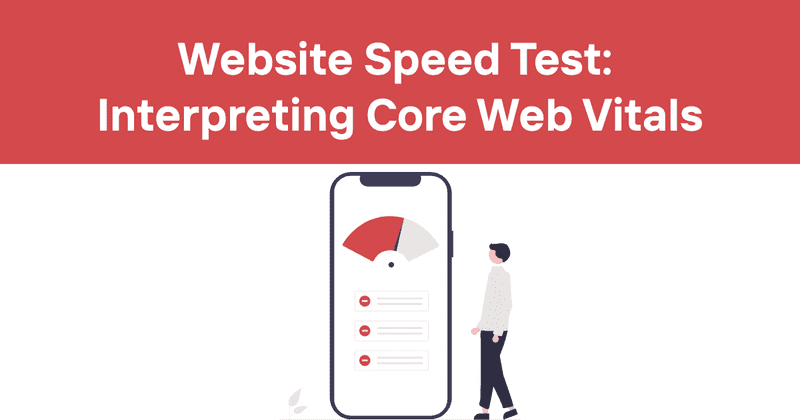Website Speed Test: Interpreting Core Web Vitals
Ever noticed how impatient you get when a website takes forever to load? You're not alone. Research shows that nearly 40% of visitors will leave a website if it takes more than 3 seconds to load. That's right—just 3 seconds standing between you and a potential customer.
I've spent years helping developers improve their sites, and if there's one thing I've learned, it's that website speed isn't just about user experience—it's about survival in the digital landscape.
Let's walk through everything you need to know about website speed tests and how to fix the issues they uncover.
Table of Contents
What is a Website Speed Test?
A website speed test is a diagnostic tool that measures how quickly your website loads and renders content to users. These tests analyze various aspects of your site's performance, from server response time to resource loading efficiency.
Speed tests don't just tell you how fast (or slow) your site is—they identify specific bottlenecks that are causing delays. Think of it as a health checkup for your website, pinpointing exactly where the problems are.
Most speed tests measure:
- Time to First Byte (TTFB)
- First Contentful Paint (FCP)
- Largest Contentful Paint (LCP)
- Time to Interactive (TTI)
- Total Blocking Time (TBT)
- Cumulative Layout Shift (CLS)
If those terms sound like gobbledygook, don't worry. We'll break them down later.
Why Website Speed Matters
Speed isn't just a nice-to-have feature—it's critical for several reasons:
SEO Impact
Google has explicitly stated that page speed is a ranking factor. Since 2021, Core Web Vitals (which are primarily speed and user experience metrics) have been incorporated into Google's ranking algorithm.
I've seen websites jump several positions in search rankings after implementing speed optimizations. It's often the lowest-hanging fruit for SEO improvements.
User Experience
Users hate waiting. Period.
According to a study by Akamai, a 100-millisecond delay in website load time can reduce conversion rates by 7%. That's literally the blink of an eye affecting your bottom line.
Conversion Rates
Slow sites kill conversions. Amazon calculated that a one-second delay in page load time could cost them $1.6 billion in sales per year. And if it matters to Amazon, it should matter to you too.
Bounce Rates
When users land on a slow page, they bounce—often before seeing any of your content. Google Analytics frequently shows a direct correlation between page speed and bounce rates.
Core Web Vitals Explained
In 2020, Google introduced Core Web Vitals as a set of specific factors that measure web usability. These metrics focus on three aspects of user experience:
Loading Performance (LCP)
Largest Contentful Paint measures how long it takes for the main content of a page to load. For a good user experience, LCP should occur within 2.5 seconds from when the page first starts loading.
Interactivity (FID)
First Input Delay measures the time from when a user first interacts with your site to the time when the browser can respond to that interaction. A good FID score is less than 100 milliseconds.
Visual Stability (CLS)
Cumulative Layout Shift measures how much the visible content of a page shifts during loading. A good CLS score is less than 0.1.
Passing these Core Web Vitals isn't just about pleasing Google—it's about creating websites that users actually enjoy using.
Best Website Speed Test Tools
There are dozens of speed testing tools available, but after years of testing and comparing, here are the ones we recommend:
Google PageSpeed Insights
Google's own tool should be your first stop. It provides:
- Separate scores for mobile and desktop
- Core Web Vitals assessment
- Real-world usage data from Chrome users
- Specific recommendations for improvement
We like that it's free and comes directly from Google—the same Google that's ranking your website.
The downside? The recommendations can be technical and sometimes lack context.
GTmetrix
GTmetrix is our go-to when we need more detailed information. It offers:
- Performance scores based on Google Lighthouse
- Waterfall charts showing load sequence
- Historical tracking of performance
- Testing from different geographic locations
GTmetrix gives you a more comprehensive view of your site's performance and explains issues in a way that's easier to understand than PageSpeed Insights.
WebPageTest
For developers who need to dig deep, WebPageTest provides:
- Multi-step transactions
- Video capture of page loading
- Content blocking and script execution
- Testing from multiple locations and browsers
This tool is incredibly powerful but has a steeper learning curve than the others.
Lighthouse (Chrome DevTools)
Built into Chrome, Lighthouse provides:
- Performance, accessibility, SEO, and best practices audits
- Simulated testing for mobile devices
- Actionable recommendations
- Export capabilities for reports
We often use Lighthouse during development because it's so convenient to access through Chrome DevTools.
Which Tool Should You Use?
Rather than picking just one, we recommend using at least two different tools. Start with Google PageSpeed Insights to understand how Google sees your site, then use GTmetrix or WebPageTest for deeper analysis.
Here's a comparison table to help you choose:
| Tool | Best For | Main Advantage | Limitation |
|---|---|---|---|
| PageSpeed Insights | SEO optimization | Direct Google insights | Technical recommendations |
| GTmetrix | Comprehensive analysis | User-friendly interface | Limited free tests |
| WebPageTest | In-depth diagnostics | Extremely detailed | Complex interface |
| Lighthouse | Development testing | Integrated with Chrome | Simulated environment only |
How to Interpret Speed Test Results
Getting test results is one thing—understanding them is another. Here's how to make sense of what you're seeing:
Look Beyond the Score
The overall score is a starting point, not the destination. A site with a score of 70 might actually load faster than one with 90 if the right metrics are optimized.
Focus on these key metrics:
- Time to First Byte (TTFB): Should be under 200ms
- First Contentful Paint (FCP): Aim for under 1.8s
- Largest Contentful Paint (LCP): Target less than 2.5s
- Time to Interactive (TTI): Should be under 3.8s
- Total Blocking Time (TBT): Keep under 200ms
- Cumulative Layout Shift (CLS): Maintain below 0.1
Prioritize Issues
Most tools will provide a list of recommendations. Not all issues are created equal. Generally, focus on:
- Server response time issues (hosting problems)
- Render-blocking resources (CSS/JavaScript issues)
- Image optimization
- Browser caching
- Minor code optimizations
Compare Mobile vs. Desktop
Often, performance issues affect mobile users more severely. Pay special attention to mobile scores, even if your desktop scores look good.
Common Performance Issues
After running thousands of speed tests for clients, I've noticed these issues come up repeatedly:
Unoptimized Images
Images are usually the largest resources on a page. Common problems include:
- Not resizing images to their display size
- Using wrong formats (JPEG for photos, PNG for graphics with transparency, WebP where supported)
- Not using responsive images
- Missing image compression
Render-Blocking Resources
These are CSS and JavaScript files that prevent the page from rendering until they're loaded. Solutions include:
- Moving JS to the bottom of the page
- Using async or defer attributes
- Inlining critical CSS
- Eliminating unnecessary third-party scripts
Poor Hosting
Your web hosting matters enormously. Issues include:
- Shared hosting with limited resources
- Hosting in datacenters far from your users
- Insufficient server resources
- No CDN implementation
Excessive HTTP Requests
Each element on your page requires a separate HTTP request. Reducing these through:
- CSS/JS bundling and minification
- CSS sprites for multiple small images
- Font subsetting
- Lazy loading non-critical resources
No Caching Implementation
Without proper caching, every visit to your site requires downloading all resources again.
Speed Optimization Techniques
Now for the fun part—fixing the issues you've identified:
Image Optimization
- Resize images to their display dimensions
- Compress images using tools like TinyPNG or Squoosh
- Implement lazy loading for images below the fold
- Use next-gen formats like WebP where supported
Minification and Compression
- Minify CSS, JavaScript, and HTML
- Enable GZIP or Brotli compression on your server
- Remove unnecessary code and inline small CSS/JS files
Browser Caching
- Set appropriate cache headers for static resources
- Implement a cache policy for different resource types
- Use cache-busting techniques for updated resources
Content Delivery Network (CDN)
A CDN distributes your content across servers worldwide, reducing latency for users regardless of their location.
- Choose a CDN that matches your geographical needs
- Configure it to cache static resources
- Ensure proper origin pull settings
Server Optimization
- Upgrade hosting if necessary
- Implement server-side caching
- Enable HTTP/2 or HTTP/3
- Optimize database queries
Critical Rendering Path
- Inline critical CSS
- Defer non-critical JavaScript
- Preload important resources
- Use async/defer attributes appropriately
Plugin/Extension Audit
If you're on a CMS like WordPress, plugins can significantly impact performance.
- Remove unnecessary plugins
- Replace heavy plugins with lighter alternatives
- Disable plugin features you don't use
Mobile Speed Testing
Mobile optimization deserves special attention because:
- Most web traffic now comes from mobile devices
- Mobile devices have less processing power
- Mobile connections can be unstable
- Google uses mobile-first indexing
When testing mobile speed:
- Use real devices when possible, not just emulators
- Test on different connection speeds (4G, 3G)
- Pay attention to touch delay issues
- Consider implementing AMP for critical pages
Monitoring Website Speed Over Time
One-time testing isn't enough. Website performance can degrade over time as you add features, content, or third-party tools.
Set up regular monitoring to:
- Track performance trends
- Catch regressions quickly
- Measure the impact of changes
- Establish performance budgets
Tools like GTmetrix and Google Search Console provide ongoing monitoring capabilities.
We recommend testing at least:
- After major site updates
- Monthly for general maintenance
- Weekly for high-traffic e-commerce sites
Using Odown for Website Performance Monitoring
While speed tests help you identify and fix performance issues, continuous monitoring ensures your site stays fast. This is where Odown comes in.
Odown provides comprehensive uptime monitoring that complements your speed optimization efforts. After all, the fastest website in the world is useless if it's down.
Benefits of Odown for Performance Monitoring
-
Real-time performance tracking: Odown monitors your website and APIs continuously, alerting you to performance degradations before they impact users.
-
Global testing network: Test your site's speed from multiple locations worldwide to ensure consistent performance for all users.
-
SSL certificate monitoring: Expired SSL certificates can cause major performance issues and security warnings. Odown tracks certificate expiration dates and alerts you before they expire.
-
Public status pages: Communicate transparently with users about performance issues through customizable status pages.
-
Downtime alerts: Get instant notifications when your site slows down or becomes unavailable, allowing for quick remediation.
Combining regular speed tests with Odown's continuous monitoring creates a powerful performance strategy. Use speed tests to identify and fix issues, then leverage Odown to ensure your optimizations continue working over time.
Conclusion
Website speed isn't just a technical metric—it's a fundamental component of user experience, SEO success, and business performance. By regularly testing your site's speed and addressing the issues uncovered, you can create faster, more effective websites that users love and search engines reward.
Remember these key points:
- Use multiple testing tools for a complete picture
- Focus on Core Web Vitals for maximum impact
- Optimize images, reduce server response time, and minimize render-blocking resources
- Implement caching and CDN solutions
- Monitor performance continuously with tools like Odown
Website speed optimization is an ongoing process, not a one-time fix. But with the right tools and approach, you can create lightning-fast experiences that keep users engaged and coming back for more.



